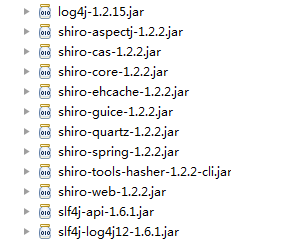1.创建一个简单shiro项目
创建一个java工程
加入shiro需要的jar包
在src下创建log4j配置文件(非必需步骤,可以跳过)
#
# Licensed to the Apache Software Foundation (ASF) under one
# or more contributor license agreements. See the NOTICE file
# distributed with this work for additional information
# regarding copyright ownership. The ASF licenses this file
# to you under the Apache License, Version 2.0 (the
# "License"); you may not use this file except in compliance
# with the License. You may obtain a copy of the License at
#
# http://www.apache.org/licenses/LICENSE-2.0
#
# Unless required by applicable law or agreed to in writing,
# software distributed under the License is distributed on an
# "AS IS" BASIS, WITHOUT WARRANTIES OR CONDITIONS OF ANY
# KIND, either express or implied. See the License for the
# specific language governing permissions and limitations
# under the License.
#
log4j.rootLogger=INFO, stdout
log4j.appender.stdout=org.apache.log4j.ConsoleAppender
log4j.appender.stdout.layout=org.apache.log4j.PatternLayout
log4j.appender.stdout.layout.ConversionPattern=%d %p [%c] - %m %n
# General Apache libraries
log4j.logger.org.apache=WARN
# Spring
log4j.logger.org.springframework=WARN
# Default Shiro logging
log4j.logger.org.apache.shiro=TRACE
# Disable verbose logging
log4j.logger.org.apache.shiro.util.ThreadContext=WARN
log4j.logger.org.apache.shiro.cache.ehcache.EhCache=WARN
- 在src下创建shiro.ini配置文件
[users]
admin = 123,role1
[roles]
role1 = printer:print用户名:admin
密码:123
为admin这个账户赋予role1角色,多个角色使用逗号隔开
role1这个角色拥有printer:print这个权限,关于这个权限的写法,后面会讲到
- HelloWorld
package com.shiro.helloworld;
import org.apache.shiro.SecurityUtils;
import org.apache.shiro.authc.AuthenticationException;
import org.apache.shiro.authc.IncorrectCredentialsException;
import org.apache.shiro.authc.LockedAccountException;
import org.apache.shiro.authc.UnknownAccountException;
import org.apache.shiro.authc.UsernamePasswordToken;
import org.apache.shiro.config.IniSecurityManagerFactory;
import org.apache.shiro.mgt.SecurityManager;
import org.apache.shiro.session.Session;
import org.apache.shiro.subject.Subject;
import org.apache.shiro.util.Factory;
import org.slf4j.Logger;
import org.slf4j.LoggerFactory;
public class HelloWorld {
//如果不使用日志,也可以直接用System.out.println(),也就可以不用配置log4j.properties了
private static final transient Logger log = LoggerFactory.getLogger(HelloWorld.class);
public static void main(String[] args) {
//获取SecurityManager的实例
Factory<SecurityManager> factory = new IniSecurityManagerFactory("classpath:shiro.ini");
SecurityManager securityManager = factory.getInstance();
SecurityUtils.setSecurityManager(securityManager);
Subject currenUser = SecurityUtils.getSubject();
//session的使用
Session session = currenUser.getSession();
session.setAttribute("key", "value");
String value = (String) session.getAttribute("key");
log.info("value:"+value);
//如果还未认证
if(!currenUser.isAuthenticated()){
UsernamePasswordToken token = new UsernamePasswordToken("admin","123");
token.setRememberMe(true);
try {
currenUser.login(token);
} catch (UnknownAccountException uae) {
log.info("没有该用户: " + token.getPrincipal());
} catch (IncorrectCredentialsException ice) {
log.info( token.getPrincipal() + " 的密码不正确!");
} catch (LockedAccountException lae) {
log.info( token.getPrincipal() + " 被锁定 ,请联系管理员");
}catch (AuthenticationException ae) {
//其他未知的异常
}
}
if(currenUser.getPrincipal() != null)
log.info("用户 "+currenUser.getPrincipal() +" 登录成功");
//是否有role1这个角色
if(currenUser.hasRole("role1")){
log.info("有角色role1");
}else{
log.info("没有角色role1");
}
//是否有对打印机进行打印操作的权限
if(currenUser.isPermitted("printer:print")){
log.info("可以对打印机进行打印操作");
}else {
log.info("不可以对打印机进行打印操作");
}
//退出登录
currenUser.logout();
System.exit(0);
}
}
- 其实我们使用shiro就为了做两件事:1. 验证用户的身份,2. 验证该用户是否有进行某个操作的权限
运行结果:
2.Shiro的权限
2.1 简单字符串
用简单的字符串来表示一个权限,如:queryPrinter
2.2 多层次管理
printer:print
其中第一部分是权限被操作的领域(打印机),第二部分是被执行的操作
多个值
多个值使用逗号隔开,如role1 = printer:print,printer:query
不一定要xxx:yyyy的形式,也可以直接使用简单字符串可以使用*号表示所有
比如printer:* ,表示你可以对打印机进行任何操作,
或者使用 *:query ,表示你在任何领域下,都有查询操作
2.2 实例级访问控制
这种情况通常会使用三个部件——第一个是域,第二个是操作,第三个是被付诸
实施的实例。如:printer:query:lp7200也可以使用通配符来定义,如:
printer:print:*
printer::
printer:*:lp7200
printer:query, print:lp7200部分省略:缺少的部件意味着用户可以访问所有与之匹配的值
printer:print 等价于 printer:print:*
printer 等价于 printer::
但是请记住:只能从字符串的结尾处省略部件,也就是说
printer:lp7200 于 并不等价于 printer:*:lp7200





 本文详细介绍了如何创建一个使用Shiro框架的简单项目,包括权限管理的实现。通过配置Shiro.ini文件,实现角色与权限的关联,并通过代码示例展示了如何验证用户身份及权限,最终达到对系统的安全访问控制。
本文详细介绍了如何创建一个使用Shiro框架的简单项目,包括权限管理的实现。通过配置Shiro.ini文件,实现角色与权限的关联,并通过代码示例展示了如何验证用户身份及权限,最终达到对系统的安全访问控制。


















 981
981

 被折叠的 条评论
为什么被折叠?
被折叠的 条评论
为什么被折叠?








